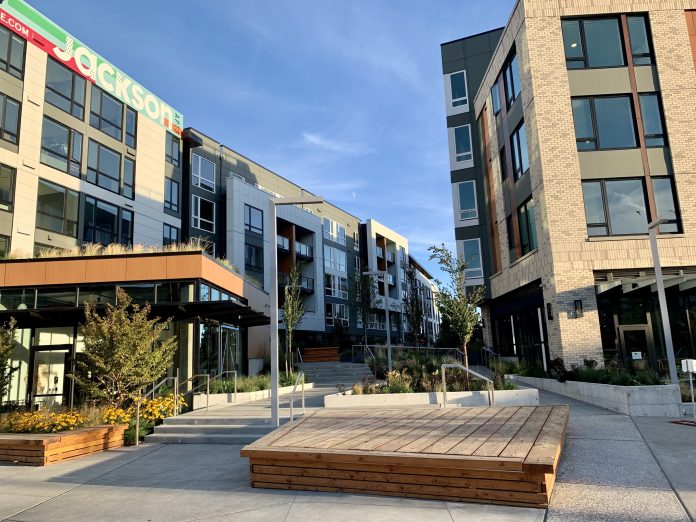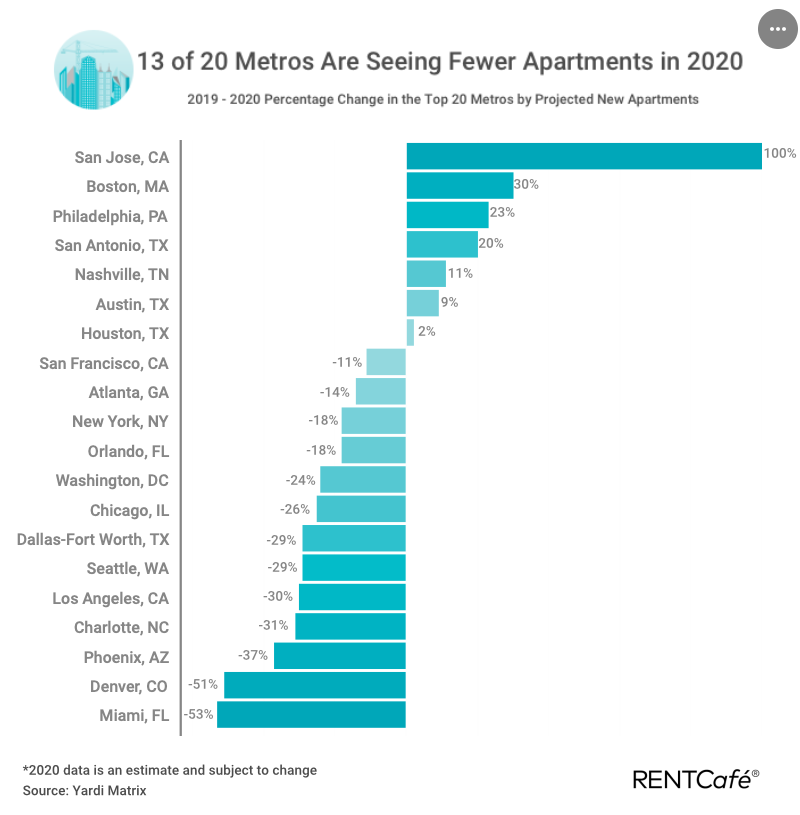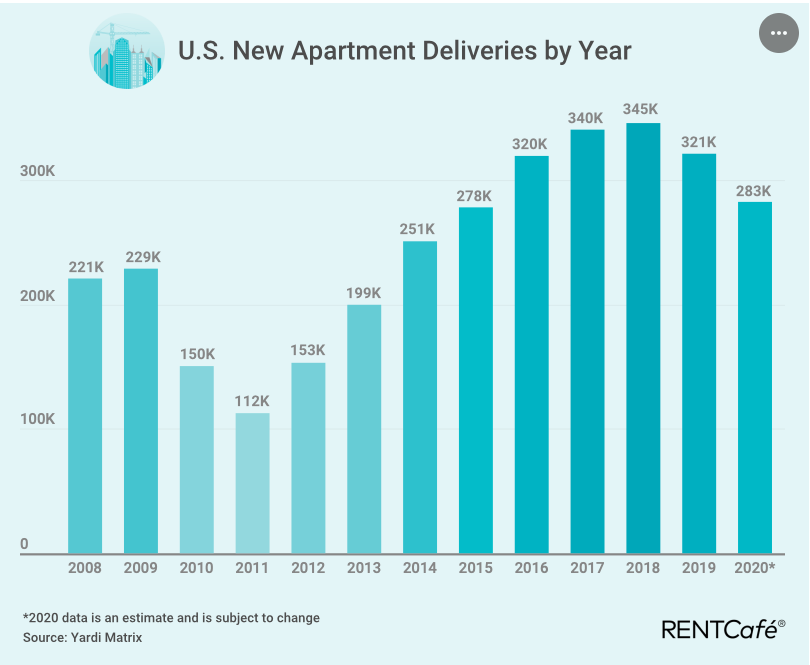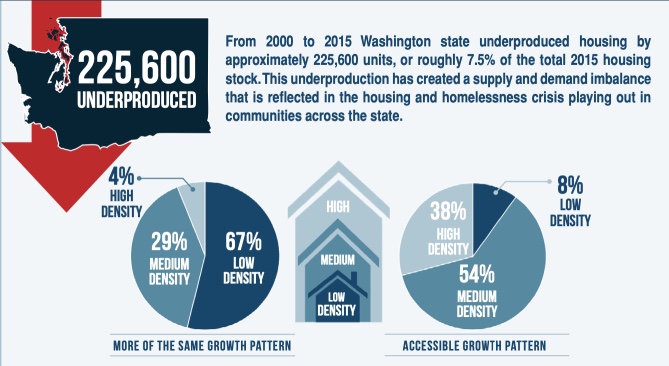
Construction of new apartments has reached a five-year low in Seattle, according to data compiled by RentCafe. While it makes sense that construction would slow down as a result of Covid pandemic, the numbers are still significant. Rentcafe estimates that 29% fewer new apartments will be completed in Seattle in 2020 compared to the previous year.
The downturn in Seattle is part of a national trend, although the decline has been more precipitous here than other parts of the country. Nationally about 12% fewer apartments are expected to enter the housing market in 2020. Based on RentCafe’s data, construction of new apartments peaked in 2018 and has been declining since then.

It is important to note that RentCafe compiles data on developments with at least 50 units, so it’s not capturing smaller buildings. Even so, the figure is likely indicative of the whole market since small buildings are relatively small portion of new production, and it’s troubling news when the numbers are transformed into the loss of thousands of actual homes. If construction remains on the same course for 2020, about 8,261 apartments will be completed in the entire Seattle area by the end of the year. That’s 3,219 fewer units than entered the market in 2019.
What’s causing the slowdown?
So far it is uncertain if or when the situation will improve. Data released in July by the National Multifamily Housing Council shows that many developers of multi-family housing have been impacted by the Covid epidemic in a variety of ways, including waits on permits, which was actually the top reason cited by developers for delays; 83% of developers who completed the survey claimed permit-related delays.
The uncertain economic climate has also made an impact. 52% of developers stated they had delayed a project because of economic uncertainty, 48% noted the lack of availability of construction financing, and another 16% claimed to have delayed a project because it was no longer financially feasible. 28% noted health and safety concerns in a nod to the fact that actually designing and constructing a building has gotten more difficult with physical distancing and other Covid safety precautions.

However, some experts believe construction may begin to experience a rebound. “Construction starts have begun to increase from their April lows and there is cautious optimism that as the year progresses construction markets around the country will begin a modest recovery,” said Doug Ressler of Yardi Matrix, an affiliate of RentCafe, in the report.

However, the road to ending Seattle’s housing affordability crisis will likely be a long one. The state of Washington has been not been building enough homes for well over a decade, and nowhere has the housing pinch been felt as painfully as in the Seattle metro area. To make matters worse, the Covid-triggered recession is exacerbating wealth inequality as service industry jobs dry up or become highly dangerous due transmission risk. Meanwhile, some major corporations in the region are reporting record profits and many of their employees are working from home, traveling less, and putting an even higher premium on housing.
Why is a slow down in apartment construction significant?
Despite the impact of Covid pandemic and ensuing recession and spike in unemployment, so far it appears the Covid pandemic has done little to lessen the surge of housing costs in the Seattle region. Recent data shows the cost of buying a home in Seattle continues to increase at one of the fastest rates in the nation; only Phoenix has experienced slightly higher price increases. In June, Seattle housing prices increased by 6.5% overall from the previous year, with the most affordable homes (those currently priced at approximately $448,000 and under) rising about 9% from where they were in 2019.
Despite record unemployment highs and eviction moratoriums passed by Governor Jay Inslee and the Seattle City Council which are keeping the estimated one in five Seattleites who cannot afford rent currently housed, rental costs have also remained high in Seattle. By Rent Jungle’s tally, while all rental costs in Seattle decreased an average of 0.14% in July from the previous year, rents for one- and two-bedroom apartments have actually increased by 1.2% and 2.2% respectively. Governor Inslee also issued a rent freeze with his eviction moratorium, so the climb in average rents must be attributable to new apartments, turnover, and/or landlords ignoring the freeze on rent hikes.

Experts believe that increasing housing supply remains crucial to achieving greater housing affordability in King County. Last year, the King County Regional Affordable Housing Task Force revised its estimates in its five year affordable housing action plan noting:
[W]e need 156,000 more affordable homes today and another 88,000 affordable homes by 2040 to ensure that no low-income or working households are cost burdened. That means we need to build, preserve or subsidize a total of 244,000 net new homes by 2040 if we are to ensure that all low-income families in King County have a safe and healthy home that costs less than 30 percent of their income.
King County Regional Affordable Housing Task Force
Prior to the Covid construction slowdown, was Seattle making progress toward this goal? Earlier this year, a study published by Construction Coverage using data from U.S. Census Bureau and Zillow Home Value Index found that the Seattle metro area ranked 13th in the U.S. for large metros making the most investments in new housing, just behind Portland. It is worth noting that Seattle was by far the most expensive metro area to make the top 15 list; its median home price of $515,000 was about 1.5 times higher than that of the number one ranked Austin, which had a median home price of $331,000. Other expensive metro areas were ranked far lower. For example, Boston and San Francisco nearly tied at 34th and 35th in the rankings.

While progress has been made, Seattle’s high costs have created a catch-22 scenario in which the high cost of land and construction slows development, exacerbating the housing shortage and further inflating costs.
Hopeful signs
Government efforts to build social housing had been rather limited in comparison to the gaping need, but Seattle City Council recent move to add a payroll excise tax to invest more than $200 million annually mostly in affordable housing creation mark a welcome exception to that. Action by the Washington State Legislature and King County Council could accelerate affordable housing creation further. Goals need to be much higher.
Permitting and design review activity remains strong. A backlog did build up until Seattle City Council passed an electronic and administrative design review work around in late April. Clearing that backlog and dealing with the steady pace of new applications has kept the Seattle Department of Construction and Inspections quite busy. Large projects are still moving forward.
Many factors have made housing development difficult and expensive in Seattle and all together they tell the story of how the city arrived at its current housing crisis. The good news is the drop in housing production hasn’t been as steep as during the Great Recession. Let’s hope that the Covid pandemic ends up being a call to action rather than yet another stumbling block.
Natalie Bicknell Argerious (she/her) is a reporter and podcast host at The Urbanist. She previously served as managing editor. A passionate urban explorer since childhood, she loves learning how to make cities more inclusive, vibrant, and environmentally resilient. You can often find her wandering around Seattle's Central District and Capitol Hill with her dogs and cat. Email her at natalie [at] theurbanist [dot] org.

